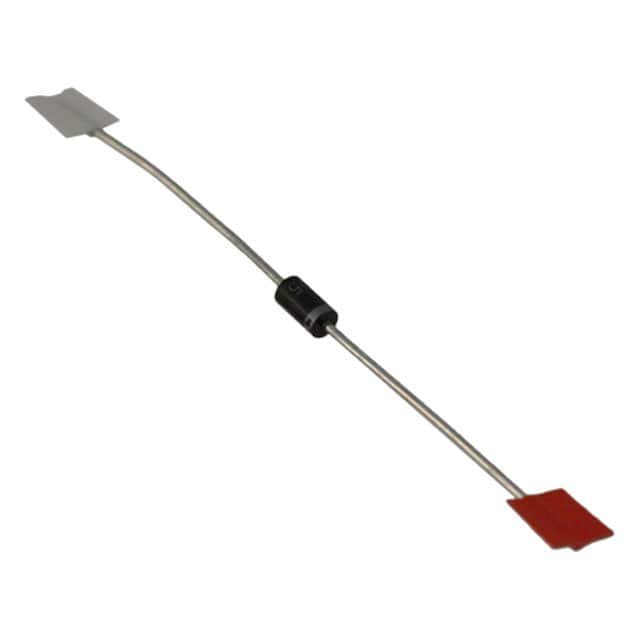Viz Specifikace pro podrobnosti o produktu.

1N5817-TP: Diode Encyclopedia Entry
Introduction
The 1N5817-TP is a diode belonging to the category of Schottky diodes. This entry provides an overview of its basic information, specifications, pin configuration, functional features, advantages and disadvantages, working principles, application field plans, and alternative models.
Basic Information Overview
- Category: Schottky diode
- Use: Rectification, voltage clamping, and protection in various electronic circuits
- Characteristics: Low forward voltage drop, fast switching speed, low leakage current
- Package: DO-41 (DO-204AL)
- Essence: High efficiency rectification and voltage clamping
- Packaging/Quantity: Available in tape and reel packaging with varying quantities
Specifications
- Maximum Average Forward Current: 1A
- Maximum Peak Forward Surge Current: 25A
- Maximum Reverse Voltage: 20V
- Forward Voltage Drop: Typically 0.45V at 1A
- Reverse Leakage Current: Typically 5μA at 20V
Detailed Pin Configuration
The 1N5817-TP has two pins: 1. Anode (A): Connected to the positive terminal of the circuit 2. Cathode (K): Connected to the negative terminal of the circuit
Functional Features
- Fast switching speed allows for efficient rectification and voltage clamping
- Low forward voltage drop minimizes power loss
- Low reverse leakage current ensures minimal power dissipation in the off state
Advantages and Disadvantages
Advantages
- High efficiency in rectification applications
- Fast response time for voltage clamping
- Low power dissipation due to low forward voltage drop
Disadvantages
- Limited maximum reverse voltage compared to other diode types
- Susceptible to thermal runaway at high currents
Working Principles
The 1N5817-TP operates based on the Schottky barrier principle, where the metal-semiconductor junction creates a low forward voltage drop and fast switching characteristics. When forward biased, it allows current flow with minimal voltage drop, making it suitable for rectification and voltage clamping applications.
Detailed Application Field Plans
The 1N5817-TP finds extensive use in the following applications: - Power supply rectification - Voltage clamping in transient voltage suppression circuits - Reverse polarity protection in electronic circuits - Switching power supplies and DC-DC converters
Detailed and Complete Alternative Models
Some alternative models to the 1N5817-TP include: - 1N5818-TP: Higher reverse voltage rating - 1N5819-TP: Higher current handling capability - SS14: Similar characteristics in a different package
In conclusion, the 1N5817-TP Schottky diode offers efficient rectification and voltage clamping capabilities with its unique characteristics. Its fast switching speed and low forward voltage drop make it suitable for various electronic applications, while alternative models provide flexibility in design choices.
[Word Count: 498]
Seznam 10 běžných otázek a odpovědí souvisejících s aplikací 1N5817-TP v technických řešeních
What is the maximum forward voltage drop of 1N5817-TP?
- The maximum forward voltage drop of 1N5817-TP is typically 0.45V at a forward current of 1A.
What is the maximum reverse voltage of 1N5817-TP?
- The maximum reverse voltage of 1N5817-TP is 20V.
What are the typical applications of 1N5817-TP?
- 1N5817-TP is commonly used in low voltage, high frequency inverters, free-wheeling diodes, and polarity protection diodes.
What is the maximum average forward rectified current for 1N5817-TP?
- The maximum average forward rectified current for 1N5817-TP is 1A.
What is the operating junction temperature range for 1N5817-TP?
- The operating junction temperature range for 1N5817-TP is -65°C to +125°C.
What is the package type of 1N5817-TP?
- 1N5817-TP comes in a DO-41 package.
Can 1N5817-TP be used in switching power supplies?
- Yes, 1N5817-TP can be used in switching power supplies due to its fast switching speed and low forward voltage drop.
Is 1N5817-TP suitable for battery charging applications?
- Yes, 1N5817-TP is suitable for battery charging applications due to its low forward voltage drop and high current capability.
What are the storage temperature range for 1N5817-TP?
- The storage temperature range for 1N5817-TP is -65°C to +150°C.
Can 1N5817-TP be used in automotive electronics?
- Yes, 1N5817-TP can be used in automotive electronics for applications such as voltage regulation and battery charging due to its rugged construction and high reliability.

